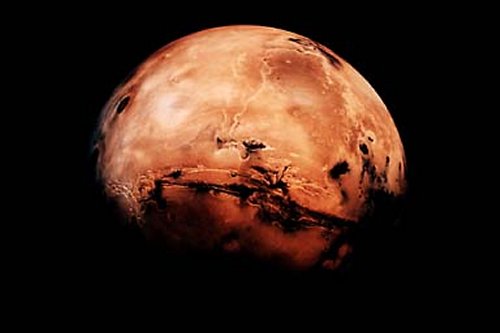
Researchers studying the lakes of liquid water that are buried under Mars’ southern polar ice caps are beginning to question whether or not these structures are indeed liquid, as the radar data would indicate, due to the lack of a heat source that would prevent the water from freezing. But if these subsurface deposits aren’t actually water, what could they be?
First discovered as bright spots in radar data returned by the Mars Advanced Radar for Subsurface and Ionosphere Sounding (MARSIS) orbiter, these subsurface regions reflected a radar return signature unique to liquid water, prompting the Italian research team that found them to conclude the structures were indeed liquid lakes. More bright spots were found in the region following the 2018 discovery, building the hope that future astronauts might have access to the vital resource while exploring the Martian surface—and the possibility that lifeforms of some sort might still thrive in the subterranean lakes.
But some of the bright spots found since the initial discovery have been fairly close to the surface of the ice caps—less than a mile deep (1.6 km)—meaning that the water in these lakes would have to somehow remain liquid in an environment that wouldn’t get much warmer than -63°C (-81°F). This is far too cold for water to remain liquid, even if the water was saturated with perchlorates, a type of salt found on Mars that can lower water’s freezing point substantially when dissolved in it.
Researchers at NASA’s Jet Propulsion Laboratory tried looking for sources of heat that could explain the presence of liquid water in an environment that would otherwise be too cold for it to exist, such as volcanism, the heat source responsible for keeping the vast ocean of Enceladus liquid. But no evidence for volcanism, or any other potential energy source for that matter, was present at Mars’ south pole, leaving the researchers with the mystery of what these bright spots might actually be.
Aside from being a potential reservoir for subsurface Martian life, identifying what these regions really are could be a make-it-or-break-it deal for future explorers visiting the planet’s southern ice cap: since it would be very resource-intensive to haul their own water all the way from Earth, having a source of water on Mars, even if it required purifying, would immensely simplify the mission’s logistics.
Subscribers, to watch the subscriber version of the video, first log in then click on Dreamland Subscriber-Only Video Podcast link.
A series of comments???
Elon Musk’s Controversial Speech That Exposed The Biggest Deceptions in The World.
https://www.youtube.com/watch?v=9IauaPnBVd4